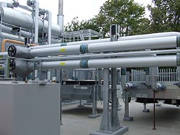ENER-G, the cogeneration specialist, has published a free guide to assessing the economic feasibility of combined heat and power (CHP) projects.
 ENER-G, the cogeneration specialist, has published a free guide to assessing the economic feasibility of combined heat and power (CHP) projects.
ENER-G, the cogeneration specialist, has published a free guide to assessing the economic feasibility of combined heat and power (CHP) projects.
Available to download, the guide details the steps that building engineers and energy and facilities managers should take to prove the viability of a proposed CHP scheme to investors or board members.
A good quality CHP system will typically generate a return on investment within three to five years and generate cost savings over 15 years or more. However, this depends on ensuring that CHP is the right solution for the particular site and sizing the system accurately to optimise efficiency and performance.
The guide presents a three-step approach to building the economic case, starting with an initial feasibility study to gather and collate data so that the site's energy load (demand) profiles can be calculated accurately.
Step two is an initial feasibility study in which the initial load profiles are used to calculate whether CHP is viable and to accurately size the system according to current and predicted future heat and power demand. The third step is an on-site review involving a review of infrastructure and other considerations, such as planning, fuel supply and environmental factors.
With data analysed, a suitable energy and carbon saving CHP system selected, and the site’s infrastructure reviewed, the final step is explained. This is how to conduct a detailed financial assessment to reveal the full lifetime costs of purchasing, operating and maintaining the system.
Head of marketing at ENER-G, Clare Burns, said: 'CHP can achieve cost savings of up to 40 per cent over electricity sourced from the grid and heat generated by on-site boilers. The savings are particularly impressive where the heating or cooling demand is for extended periods, but it's crucial to complete a thorough feasibility study to demonstrate that the building's load profile warrants cogeneration technology and to use this data to specify the correct system size. Our guide details all the steps required to prove the case for CHP and ensure a sound and timely investment.'
Download the ENER-G CHP Economic Feasibility Guide at http://chpcontent.energ-group.com/energ-plan-economic-feasibility